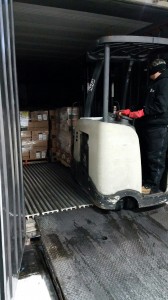
Imagine those preparations on a global scale. Dan Chase lives and breathes details. He’s at the helm of a team of 7 of people who work in logistics for SYSCO International Food Group, near Plant City, Fla.
By the latest tally, beef exports add $326.92 to the value of cattle, and without people like Dan, that simply wouldn’t be possible.
The team gets an order, secures the product from the plant, and then preps the beef for its final destination.
“We have a tri-lingual labeling team that creates the labels and then opens each box to attach it to each individual piece,” says the industry veteran.
At the same time, they’re doing some math. They find out what else is being shipped with the beef, as everything from cheese and peanut butter to cups and plates might need to fit in the same 20-foot or 40-foot container (that’s up to 50,000 lb. of goods to coordinate). They arrange a steamship line, trucking to get that container to the port, and a way to get the empty one back. They make sure nothing will expire before it reaches its destination.
And once the food is on the ocean, it’s smooth sailing. Ah, just kidding. Then, it’s “go time.”

“All documents have to be notarized and have to go to the consulate in their country and they’ll stamp them and send them back to us,” he says. The process generally takes two to three weeks, and they’re on a timeline, because they want the paperwork to beat the product to port.
Dan and his team are thorough and confident. “It’s the outside sources we cannot control,” he says. Like when an embassy runs out of notary stickers (yes, that really happens, and more frequently than you’d think), and the process comes to screeching halt.

Although most of the logistics team has probably never rounded up loose calves, I am confident they approach lost documents with the same sense of urgency. If overseas customers want high-quality U.S. beef, they don’t want them to wait.
The next time you sell cattle, maybe take a minute to appreciate folks like Dan Chase who are “riding herd,” making sure your beef gets to consumers across the globe. They’ve certainly helped beef up your bottom line.
May that bottom line be filled with Black Ink,
Miranda
PS–Want to catch up on the whole series? Check out these links below:
- Introduction: Nice to Meat Ya
- Day 1: Ashley Pado
- Day 2: Scott Redden
- Day 3: Jesse Stucky
- Day 4: Bridget Wasser
- Day 5: Amanda Barstow
- Day 6: Josh Moore
- Day 7: Ruth Ammon
- Day 8: Bill Tackett
